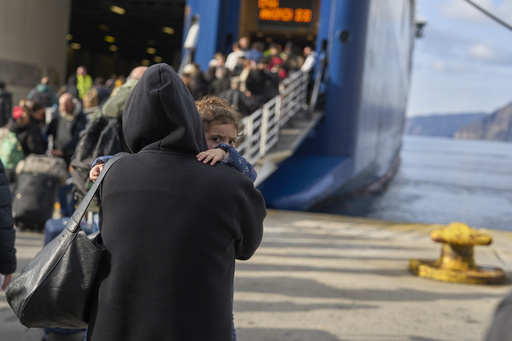SANTORINI, Greece — Emergency rescue teams were sent to Greece’s famous volcanic island of Santorini on Monday as authorities reacted to an increase in seismic activity that raised fears of a significant earthquake. Hundreds of residents and tourists hastily sought to evacuate the island, prompting schools on four nearby islands to close until Friday.
Precautionary measures extended to several neighboring islands in the Aegean Sea, which are renowned summer destinations, as over 200 undersea tremors were detected in the region over a span of three days. Prime Minister Kyriakos Mitsotakis, speaking from a European meeting in Brussels, addressed the situation, saying, “We are dealing with a significant geological phenomenon. I urge the residents to remain calm and follow the guidance from the Civil Protection authority.”
As alarm bells rang on mobile phones across Santorini, alerts issued warnings about possible rockslides, and numerous earthquakes produced audible rumbles. Authorities enforced restrictions on access to areas close to cliffs, including the old seaside port.
“The steps taken are purely precautionary, and we remain on high alert,” stated Civil Protection Minister Vasilis Kikilias after an emergency meeting in Athens. “We encourage citizens to thoroughly follow safety guidelines to mitigate any risks.” Despite expert assessments indicating that the quakes, reaching up to magnitude 4.9, are not directly connected to the Santorini volcano, scientists acknowledge that the ongoing seismic activity is indeed alarming.
Throughout the weekend and into Monday, government officials consulted with scientists to evaluate the circumstances, leading to the decision to close schools on nearby islands such as Amorgos, Anafi, and Ios for the week.
The frequent quakes have instilled a sense of anxiety among residents and tourists alike. Michalis Gerontakis, director of the Santorini Philharmonic Orchestra, shared his experience: “I’ve never experienced earthquakes with such regularity — every 10 to 20 minutes. While people try to conceal their worries to avoid panic, many are genuinely afraid.” He added that despite the tremors, the orchestra performed for a religious event, noting, “You can’t feel the quakes while playing, but they occur even during such gatherings.”
Tourists and residents have been advised to steer clear of large indoor gatherings and hazardous cliffs, while hotel managers have been instructed to empty swimming pools to minimize potential structural damage.
A team of firefighters arrived on the island on Sunday, setting up yellow tents in a basketball court next to the main hospital. Fire brigadier Ioannis Billias reported that the rescue team consists of 26 members and a rescue dog, further explaining that many locals chose to sleep in their cars due to safety concerns.
Many locals have sought tickets for flights or ferries away from the island. “We’ve experienced quakes before but nothing like this. It feels different now,” said Nadia Benomar, a tour guide from Morocco who has resided in Santorini for nearly two decades. Having purchased a ferry ticket to the nearby island of Naxos, she stated, “I just need some time away until this calms down.”
On Monday afternoon, a long line of vehicles and people formed at the main port as they tried to board ferries leaving Santorini. Conversely, some have opted to take their chances. Yiannis Fragiadakis, a restaurant worker who returned to the island despite the quakes, expressed, “I wasn’t afraid. I know many are anxious and fleeing. When I reached the port, it felt like summer with the hustle and bustle.”
Soo Jin Kim, a tourist from South Korea, shared her experiences after arriving on Sunday with her family. “We had dinner at our hotel last night and felt subtle shakes about ten times, but it was the big jolt at midnight that made us check the news. We are somewhat worried, but we plan to stick to our itinerary.”
Crescent-shaped Santorini is a leading tourist attraction, with millions of visitors coming annually through flights, ferries, and cruises. The island features picturesque white buildings perched on dramatic cliffs formed by a massive volcanic eruption estimated to have occurred over 3,500 years ago. This eruption, around 1620 B.C., devastated a significant area of the island and has been linked to the decline of the ancient Minoan civilization.
Despite being an active volcano, its last major eruption occurred in 1950. Renowned seismologist Gerasimos Papadopoulos cautioned that the ongoing sequence of earthquakes — visible on real-time seismic maps as a series of clustered events between Santorini, Ios, Amorgos, and Anafi — could signal a larger forthcoming event. “All possibilities remain on the table,” he noted, adding that the frequency and intensity of tremors have raised concerns.
In response to the situation, officials in Fira, Santorini’s main town, have identified potential gathering locations for residents if evacuation becomes necessary. Mayor Nikos Zorzos reassured the public that these preparations are precautionary. “We must be ready, but preparation does not imply that an incident will occur,” he stated firmly. He urged the community to remain composed, emphasizing that media reports can sometimes exaggerate the circumstances.
